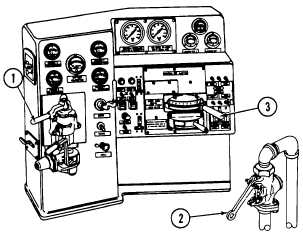TM 55-2210-224-12
2-26. EMERGENCY APPLICATION OF BRAKES (cont)
c. After stopping, wait 2 minutes, then place automatic brake valve (1) in RELEASE position for at least 30
seconds, then move to SUPPRESSION.
d. Brake pipe pressure falling to ZERO indicates an air hose is parted or a brake pipe is broken. In either case,
move automatic brake valve (1) to RELEASE position to provide pressure for trainman to locate the defect. If
brake pipe is not broken or hose parted, leave automatic brake valve in RELEASE position to release brakes.
2-27. BRAKING WITH POWER
When braking with power, drawbar pull rapidly increases as the speed decreases for any given
throttle handle position. This pull may be great enough to part the train unless the throttle handle is
reduced as the train loses speed. The load meter indicates the pull of the locomotive. A constant
pull can be maintained on the train during a slowdown if a steady amperage is kept on the load meter
by consecutively reducing the throttle handle a notch whenever the amperage starts to increase.
Keep the independent brake fully released during power braking. The throttle handle must be in
IDLE position before the locomotive comes to a stop.
2-28. EMERGENCY STOP
CAUTION
Before resuming operation after an
emergency brake application, inspect
equipment for possible damage. Make
sure all brakes apply and release
properly. To stop the train in the
shortest possible time (to save life or
avoid an accident), move automatic
brake valve handle (1) quickly to the
EMERGENCY position or trip emergency brake valve (2), and move throttle handle
(3) to IDLE position.
2-29. MULTIPLE-UNIT OPERATION
a. Description.
(1) Two or more locomotives equipped for multiple-unit operation may be handled by a single operator if
connections are properly made. In addition to the conventional coupling of locomotive drawgear and air
lines, the electrical control circuits of the locomotives must be connected with a jumper which plugs into
the receptacles at the ends of the locomotives. ,
(2) Controls are then set so that power and brakes on all locomotives are controlled from one cab. The
controlling locomotive is the leading unit, and any coupled locomotives are trailing units.
2-39

